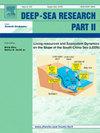Unveiling marine heatwave dynamics in the Persian /Arabian Gulf and the Gulf of Oman: A spatio-temporal analysis and future projections
IF 3
3区 地球科学
Q2 OCEANOGRAPHY
Deep-sea Research Part Ii-topical Studies in Oceanography
Pub Date : 2024-11-08
DOI:10.1016/j.dsr2.2024.105435
引用次数: 0
Abstract
Amid escalating global marine heat waves, the Arabian Gulf is critical due to its shallow depths, high temperatures, and vulnerability to climate change impacts. This study provides a detailed spatio-temporal analysis of marine heatwave events from 1982 to 2022 across the Arabian Gulf and the adjacent Gulf of Oman. The study delineates regions of heightened vulnerability within these water bodies by comprehensively analyzing seasonal and annual variabilities and trend assessments. Moreover, an exploration of prevailing surface circulation patterns, underpinned by an extensive study of global circulation model outputs, elucidates the oceanographic mechanisms contributing to temperature dynamics. Identifying 25 significant heat wave events, with a focused examination of the six most protracted episodes, is noteworthy among the findings. Strikingly, the analysis reveals that the Gulf of Oman surpasses the Arabian Gulf in heatwave intensity. Looking forward, the investigation extends to future surface water temperature projections up to the close of the current century. The collective results underscore the region's acute susceptibility to the climate change perturbations of climate change, emphasizing the urgency of targeted interventions to mitigate these effects and address concurrent local stressors.
揭示波斯湾/阿拉伯湾和阿曼湾的海洋热浪动态:时空分析和未来预测
在全球海洋热浪不断升级的情况下,阿拉伯湾因其水深较浅、温度较高以及易受气候变化影响而显得至关重要。本研究对 1982 年至 2022 年阿拉伯湾和邻近的阿曼湾的海洋热浪事件进行了详细的时空分析。该研究通过全面分析季节和年度变化及趋势评估,划定了这些水体中易受影响的区域。此外,在对全球环流模型输出进行广泛研究的基础上,还对当前的海面环流模式进行了探讨,从而阐明了导致温度动态变化的海洋学机制。研究结果中值得注意的是确定了 25 次重大热浪事件,并重点研究了 6 次持续时间最长的热浪事件。引人注目的是,分析表明阿曼湾的热浪强度超过了阿拉伯湾。展望未来,调查将延伸至本世纪末的未来地表水温度预测。这些综合结果突出表明,该地区极易受到气候变化的干扰,强调迫切需要采取有针对性的干预措施,以减轻这些影响并解决当地同时存在的压力因素。
本文章由计算机程序翻译,如有差异,请以英文原文为准。
求助全文
约1分钟内获得全文
求助全文
来源期刊
CiteScore
6.40
自引率
16.70%
发文量
115
审稿时长
3 months
期刊介绍:
Deep-Sea Research Part II: Topical Studies in Oceanography publishes topical issues from the many international and interdisciplinary projects which are undertaken in oceanography. Besides these special issues from projects, the journal publishes collections of papers presented at conferences. The special issues regularly have electronic annexes of non-text material (numerical data, images, images, video, etc.) which are published with the special issues in ScienceDirect. Deep-Sea Research Part II was split off as a separate journal devoted to topical issues in 1993. Its companion journal Deep-Sea Research Part I: Oceanographic Research Papers, publishes the regular research papers in this area.

 求助内容:
求助内容: 应助结果提醒方式:
应助结果提醒方式:


